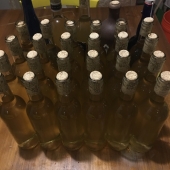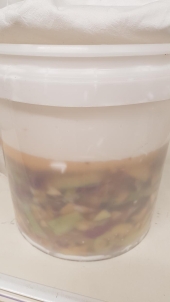sheila reavill wrote:Did you use clay to pull out the extra dead yeast bodies? I'm asking because you said it was a little cloudy. I don't make mead, but I've watched my partner make it several times. It is delicious, and I really like what he calls "dragon's breath." He freezes the mead and that separates the water out, so it becomes stronger still. Those bottles look beautiful. Looks like you are set for the season.
Freeze-distillation is also known as "jacking" (it's where we get the phrased "jacked up" from) so another name for freeze-distilled mead would be honeyjack. It works because the freezing point of alcohol is much lower than the freezing point of water, so the ice in a partially-frozen barrel of cider will be almost pure water, which any liquid will have much more alcohol in. I'm making maple wine soon, and am thinking about turning some of it into maplejack.
One of the key features of jacking is that it gets rid of primarily water, and concentrates everything else in the source liquor, including unwanted chemicals like methanol and fusel oils. Heat-distillation allows the distiller to remove some or all of the fusel oils, depending on what the end product will be. E.g. whisky and grain vodka are basically the same drink (distilled beer) the difference being the presence/absence (respectively) of fusel oils and other flavours due to the differing methods of distillation and filtering.
Similarly cider can be turned into either applejack (by freeze distillation) or cider brandy (e.g. calvados, by heat distillation). Since what is sold commercially as "applejack" is heat-distilled, it's actually cider brandy and not applejack at all. The only way to get genuine applejack is to make it yourself, which is fortunately fairly simple: get a big bottle of cider, part-freeze it, and what doesn't freeze will be higher in alcohol. Remove the ice, repeat until it's strong enough for your liking, then enjoy!








